How To Have A Healthy Diet High In Protein
Protein is a key macronutrient composed of amino acids. Found in every cell in the human body, it helps in building muscle, repairing damaged tissue, and regulating the metabolism. Approximately forty-three percent of the body's protein is found in skeletal muscles, and fifteen percent is located in the blood. Another fifteen percent is found in the skin, and the remainder is reserved for use by other parts of the body, including enzymes and hormones. Currently, the recommended daily intake of protein varies according to gender, age, and weight. For adult men and women aged nineteen and above, the recommended daily intake of complete protein (protein that provides all essential amino acids) is 0.8 grams per kilogram of body weight (seven grams for every twenty pounds of body weight). Thus, an individual who weighs 140 pounds would need roughly fifty grams of complete protein each day, and someone weighing two hundred pounds would need around seventy grams.
Health officials recommend obtaining as much protein as possible from natural food sources. Nutritionists often advise patients looking to increase their protein intake to adopt some of the healthy habits outlined below.
Avoid Processed Meats

Several recent studies suggest processed meat is linked to an increased risk of both cancer and cardiovascular disease. For this reason, leading health organizations now advocate for everyone to avoid processed meats as much as possible. Processed meats such as salami, bacon, hot dogs, and luncheon meats contain very high levels of nitrates, an ingredient some studies have classified as carcinogenic. The high sodium content of processed meats could also lead to high blood pressure, a major risk factor for stroke and cardiovascular disease. Many types of processed meats, including bacon, contain high levels of saturated fat, another ingredient known to increase cholesterol readings and contribute to obesity.
Read more about how to have a healthy diet high in protein now.
Choose Lean Meats

Patients who need more protein in their diets may wish to choose lean meats such as white meat chicken or turkey. To be classified as lean meat, a 3.5-ounce serving must have under ten grams of total fat and 4.5 grams of saturated fat. Lean meats are also required to contain less than ninety-five milligrams of cholesterol. The latest guidelines from major health organizations recommend eating eight to nine servings of lean meat each week, and experts suggest aiming for just slightly more than one portion per day. All visible fat should be removed from meat before cooking, and chicken should be cooked without the skin. Generally, baking, grilling, and broiling are the healthiest methods for cooking meat.
Keep reading to learn more about healthy ways to increase dietary protein now.
Don't Forget About Beans And Nuts

For optimal health, patients must not forget about beans and nuts, which can both be vital sources of protein, especially for those who are vegan or vegetarian. For reference, a four-ounce serving of chicken breast has twenty-eight grams of protein. By comparison, a single cup of cooked soybeans (edamame) contains 31.3 grams of protein, roughly sixty-three percent of the recommended daily protein intake for adults. Lentils contain 17.9 grams of protein per cup, and white beans have 17.4 grams of protein per cup. Other beans high in protein include split peas, kidney beans, pinto beans, and lima beans.
In addition to beans, nuts can also be a good source of protein. However, while beans are relatively low in fat, most nuts have a high fat content, so experts recommend consuming these in moderation. Almonds are one of the healthiest nuts, and a one-ounce serving contains roughly six grams of protein. Pistachios, cashews, peanuts, and walnuts contain four to six grams of protein per ounce. Nuts are ideal as a snack or sprinkled over a salad. When possible, opt for unsalted nuts that have been dry roasted.
Discover additional pieces of advice for having a healthy diet high in protein now.
Keep Fatty Fish In The Rotation

To boost intake of both protein and heart-healthy omega-3 fatty acids, experts recommend for individuals to keep fatty fish in the rotation. Examples of fatty fish include salmon, tuna, mackerel, sardines, trout, and herring. Most health organizations recommend adults eat at least two servings of fatty fish each week; each serving should be roughly 3.5 ounces. Since some fish can be high in mercury, choosing a low-mercury option such as salmon or herring is advisable. Pregnant women should limit their intake of tuna to no more than six ounces three times a month due to its relatively high mercury content. Where possible, choosing organic or wild-caught fish is beneficial, and baking fish is much healthier than frying it. To make it easier to include fish in the weekly menu, it could be helpful to include tuna in a casserole or a sandwich, and some individuals might enjoy a fish stew. Patients concerned about mercury levels should consult a medical professional.
Learn more about maintaining a healthy diet high in protein now.
Choose High-Fiber And Nutrient-Dense Carbohydrates

Individuals who choose high-fiber and nutrient-dense carbohydrates can easily increase their protein intake, and protein-rich carbohydrates are particularly important for individuals who do not eat meat. Quinoa, oats, and chickpeas are ideal plant-based sources of protein and fiber. A one-cup serving of quinoa contains 39.4 grams of carbohydrates, including 5.2 grams of dietary fiber, and it has 8.1 grams of protein (sixteen percent of the recommended daily intake). By comparison, a one-cup portion of oats has 103 grams of carbohydrate, 16.5 grams of dietary fiber, and 26.4 grams of protein. When boiled without salt, an eight-ounce serving of chickpeas provides forty-five grams of carbohydrate, 12.5 grams of dietary fiber, and 14.5 grams of protein. All of these foods can be easily incorporated into the majority of diets. Quinoa is particularly good as a substitute for rice in stir fry, and its texture makes it an ideal substitute for hamburger in tacos. Oats can be included in granola bars or cooked for a breakfast cereal, and chickpeas work well when tossed in a salad or eaten as hummus.